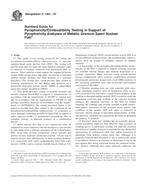Potřebujeme váš souhlas k využití jednotlivých dat, aby se vám mimo jiné mohly ukazovat informace týkající se vašich zájmů. Souhlas udělíte kliknutím na tlačítko „OK“.
ASTM C1454-07
Standard Guide for Pyrophoricity/Combustibility Testing in Support of Pyrophoricity Analyses of Metallic Uranium Spent Nuclear Fuel (Withdrawn 2016)
Automaticky přeložený název:
Standardní příručka pro samozápalnost / hořlavosti Testování na podporu samozápalnost analýz kovového uranu vyhořelého jaderného paliva
NORMA vydána dne 1.2.2007
Informace o normě:
Označení normy: ASTM C1454-07
Poznámka: NEPLATNÁ
Datum vydání normy: 1.2.2007
Kód zboží: NS-11355
Počet stran: 12
Přibližná hmotnost: 36 g (0.08 liber)
Země: Americká technická norma
Kategorie: Technické normy ASTM
Anotace textu normy ASTM C1454-07 :
Keywords:
combustion, ignition, pyrophoricity, spent nuclear fuel, spontaneous ignition, uranium metal, uranium metal oxidation, zirconium pyrophricity, zirconium oxidation, ICS Number Code 27.120.30 (Fissile materials and nuclear fuel technology)
Doplňující informace
| 1. Scope | ||||||||
|
1.1 This guide covers testing protocols for testing the pyrophoricity/combustibility characteristics of metallic uranium-based spent nuclear fuel (SNF). The testing will provide basic data for input into more detailed computer codes or analyses of thermal, chemical, and mechanical SNF responses. These analyses would support the engineered barrier system (EBS) design bases and safety assessment of extended interim storage facilities and final disposal in a geologic repository. The testing also could provide data related to licensing requirements for the design and operation of a monitored retrievable storage facility (MRS) or independent spent fuel storage installation (ISFSI). 1.2 This guide describes testing of metallic uranium and metallic uranium-based SNF in support of transportation (in accordance with the requirements of 10CFR71), interim storage (in accordance with the requirements of 10CFR72), and geologic repository disposal (in accordance with the requirements of 10CFR60/63). The testing described herein is designed to provide basic data related to the evaluation of the pyrophoricity/combustibility characteristics of containers or waste packages containing metallic uranium SNF in support of safety analyses (SAR), or performance assessments (PA) of transport, storage, or disposal systems, or a combination thereof. 1.3 Spent nuclear fuel that is not reprocessed must be emplaced in secure temporary interim storage as a step towards its final disposal in a geologic repository. In the United States, SNF, from both civilian commercial power reactors and defense nuclear materials production reactors, will be sent to interim storage, and subsequently, to deep geologic disposal. U.S. commercial SNF comes predominantly from light water reactors (LWRs) and is uranium dioxide-based, whereas U.S. Department of Energy (DOE) owned defense reactor SNF is in several different chemical forms, but predominantly (approximately 80 % by weight of uranium) consists of metallic uranium. 1.4 Knowledge of the pyrophoricity/combustibility characteristics of the SNF is required to support licensing activities for extended interim storage and ultimate disposition in a geologic repository. These activities could include interim storage configuration safety analyses, conditioning treatment development, preclosure design basis event (DBE) analyses of the repository controlled area, and postclosure performance assessment of the EBS. 1.5 Metallic uranium fuels are clad, generally with zirconium, aluminum, stainless steel, or magnesium alloy, to prevent corrosion of the fuel and to contain fission products. If the cladding is damaged and the metallic SNF is stored in water the consequent corrosion and swelling of the exposed uranium enhances the chemical reactivity of the SNF by further rupturing the cladding and creating uranium hydride particulates and/or inclusions in the uranium metal matrix. The condition of the metallic SNF will affect its behavior in transport, interim storage or repository emplacement, or both, and therefore, influence the engineering decisions in designing the pathway to disposal. 1.6 Zircaloy spent fuel cladding has occasionally demonstrated pyrophoric behavior. This behavior often occurred on cladding pieces or particulate residues left after the chemical dissolution of metallic uranium or uranium dioxide during fuel reprocessing of commercial spent fuel and/or extraction of plutonium from defense reactor spent fuel. Although it is generally believed that zirconium is not as intrinsically prone to pyrophoric behavior as uranium or plutonium, it has in the past ignited after being sensitized during the chemical extraction process. Although this guide primarily addresses the pyrophoricity of the metallic uranium component of the spent fuel, some of the general principles involved could also apply to zirconium alloy spent fuel cladding. 1.7 The interpretation of the test data depends on the characteristics of the sample tested and/or the usage to which the test results are put. For example, usage could include simple comparison of the relative ignition temperature of different sample configurations or as inputs to more complex computer simulations of spontaneous ignition. The type and the size of the SNF sample must be chosen carefully and accounted for in the usage of the data. The use of the data obtained by the testing described herein may require that samples be used which mimic the condition of the SNF at times far into the future, for example, the repository postcontainment period. This guide does not specifically address methods for `aging' samples for this purpose. The section in Practice C 1174 concerning the accelerated testing of waste package materials is recommended for guidance on this subject. |
||||||||
| 2. Referenced Documents | ||||||||
|




 Cookies
Cookies
